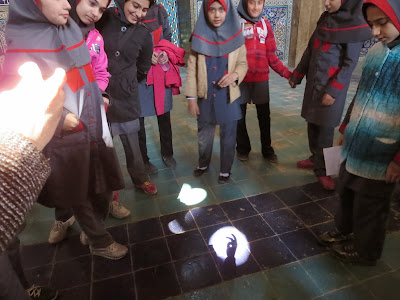After about an hour’s drive we arrived in Kashan, an oasis city in the desert. We had a nice lunch of kebabs and rice at a
traditional Kashan tea house and then walked to the Borujerdi House to discover it was unexpectedly closed. The only thing we saw was the old wooden
doors with two unusually shaped door knockers.
Milad explained that the two distinct shapes make two distinct sounds. A man would use the knocker on the right and a woman would use the knocker on the left. The woman of the house would then know the sex of the person at the door and could answer it if a woman was knocking. If a man knocked, a man would answer the door.
Moving on, we went to the fabulous Tabatabei House, a jewel in a city full of beautiful old
traditional homes. Here we were definitely
not disappointed, every surface of this house seemed to be ornamented and
embellished by fine stone carvings, elaborate stucco work or mirror mosaics. The pale walls and mirrors
glinted in the brilliant blue sunshine.
It was lovely walking
through the courtyards and various rooms to admire this splendid display of a
merchant’s wealth. While we were at
Tabatabei House, I was approached by a gentleman asking how long I would be in
Kashan. He told me he was making a movie
about tourism in Iran and would like me to be in it. He was scouting locations and would shoot it the following day. I regretfully told him I would only be in Kashan for the afternoon and would have loved to talk about my visit to Iran.
Kashan proved to be secretive.
We arrived at Fin Garden only
to find that they had unexpectedly closed early. Milad talked to someone through a narrow
opening of the old, massive wooden doors.
He tried his best to convince the gatekeeper to let us in but was unsuccessful. I would have to visit Kashan
another time to see all of her glories.
Before leaving Kashan, we made one last stop to see the Agha Bozorg Mosque & Madraseh. We entered the mosque through a wooden door said to have as many studs as there are verses in the Koran. Once inside, we saw the mosque has an unusual sunken courtyard. I could only imagine how beautiful it would be in couple of weeks when the bare trees and plants in the courtyard have leaves.
Dinner was supposed to be at 7:30 but Isfahan traffic had other plans for us. It seemed everyone was in their car, trying to go someplace all at the same time. We sat, stuck in traffic, while time flew by. Eventually we did arrive, almost an hour late. Fortunately, Tara, her husband Simon, and guide Mehdi waited for us.
 |
| photo courtesy of Tara |
 |
| photo courtesy of Tara |
 |
| photo courtesy of Tara |
The first bridge we visited was near the Abbasi Hotel, the Si-o-se-pol. A bridge of thirty three arches, the
Si-o-se-pol is a graceful structure and was especially beautiful at night when the
arches were illuminated with a golden light. Buildings and walkways along the
banks of the Zayandeh River were also lit and the atmosphere was magical. Many
people were gathered here to relax and sit beside the water rushing over the
locks of the dam under the bridge.
We then went to see another one of the eleven bridges which cross the Zayandeh, the Khajoo Bridge. Milad said this bridge was even more beautiful and was his favorite. Similar to the Si-o- se-pol, the Khajoo was a bit smaller with a span of twenty four arches. People were gathered here too, strolling along the top level and singing in the arches below. When people heard us speaking English, we became the center of attention. Many asked us questions about our visit and whether we were enjoying our time in Iran. Some ask to exchange email addresses and to become Facebook friends. It was a heady experience and it felt nice to be the recipient of so much good will and friendly curiosity. It was a good end to a long day. The next morning we left for Yazd, a place described by Marco Polo as “a very fine and splendid city.”


















































